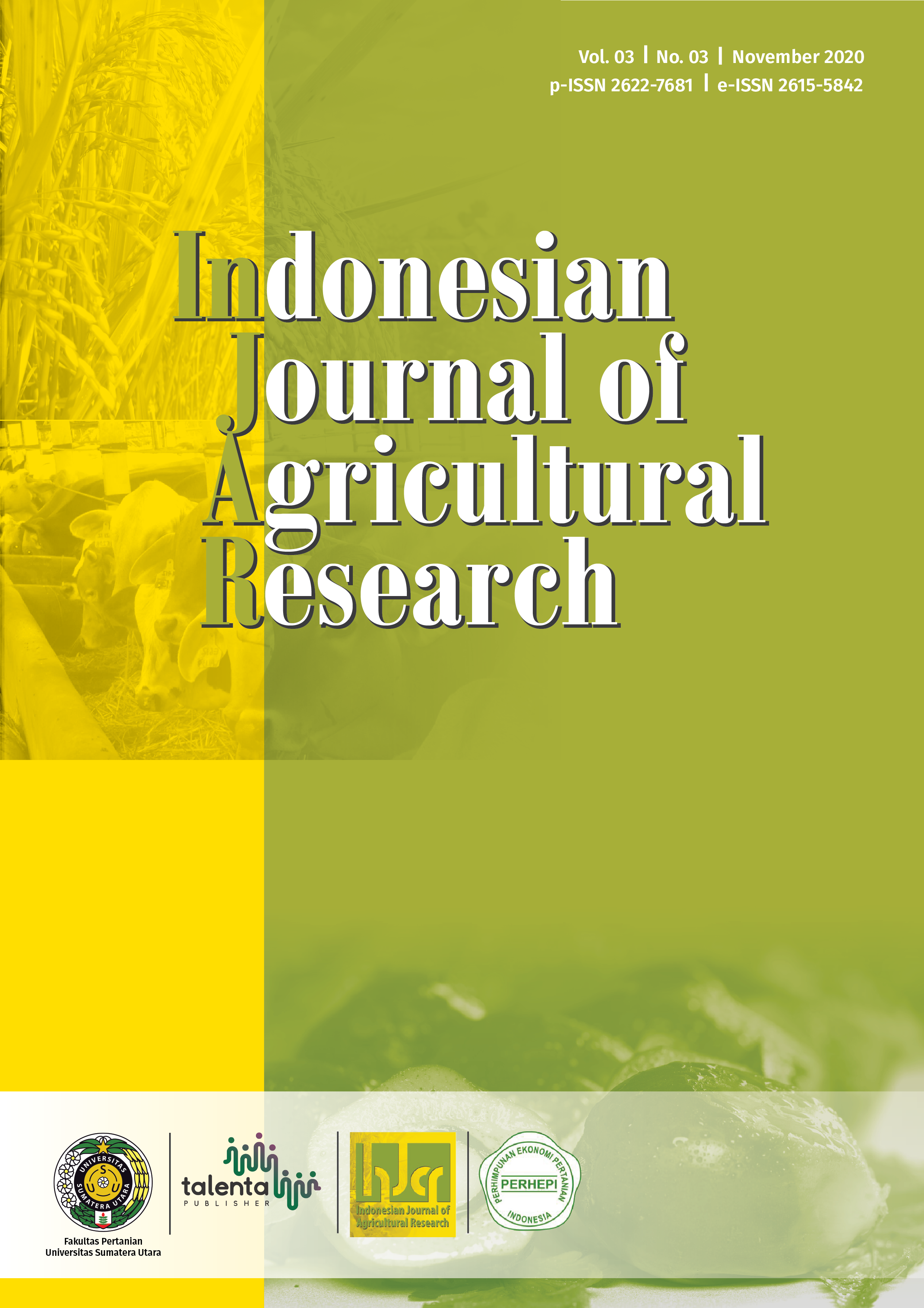Development Model on Prevention of Land and Forest Fire in the Peat Land Area with Empowerment Society Approach (Case Study in West Kalimantan)
DOI:
https://doi.org/10.32734/injar.v3i3.4448Keywords:
changing behavior, land burning behavior, peatland firesAbstract
Land fires are an annual agenda in Indonesia, especially in areas covered by peatlands. Peatland management using fire is the main cause. The general paradigm for land fires is that the farmers' economy is low. In fact, the factors that cause land fires are not only from the economic aspect, but from the social and institutional aspects which affect the behavior of farmers. Therefore, the purpose of this study is (1) to analyze the correlation of factors that influence land burning behavior, and (2) to determine the model for the changing of burning behavior into non burning farm land cultivation, in order to prevent land fire in Kuburaya Disrict and Bengkayang District, West Kalimantan. The research involved farmers farming on peatlands in both districts. Regression models was used for the correlation analysis. Based on the results of the regression analysis, a land burning behavior change model was determined based on the influencing factors descriptively. The result of the analysis showed the factors that significantly influence land burning behavior at the household level are knowledge level (consist of farming problems faced by farmers, agricultural extension materials and the application of technology), observance of rules, activeness of mutual assistance, cosmopolitan level, appraisal on burning behavior, and imitation level. The resulting model for changing the behavior of burning land is implementing activity of assistance, social capital stimulus and positive agreements/ pressure to the land users.
Downloads
References
I. Zulkifli and L. Kamarubayana, “Studi Pengendalian Kebakaran Hutan di Wilayah Kelurahan Merdeka Kecamatan Samboja Kalimantan Timur,†AGRIFOR, vol. 16, no. 1, pp. 141–150, 2017.
S. A. Cahyono, S. P. Warsito, W. Andayani, and D. H. Darwanto, “Faktor-faktor yang mempengaruhi kebakaran hutan di indonesia dan implikasi kebijakannya,†J. Sylva Lestari, vol. 3, no. 1, pp. 103–112, 2015.
A. Loren, M. Ruslan, F. H. Yusran, and F. Rianawati, “Analisis Faktor Penyebab Kebakaran Hutan dan Lahan Serta Upaya Pencegahan yang Dilakukan Masyarakat di Kecamatan Basarang Kabupaten Kapuas Kalimantan Tengah,†EnviroScienteae, vol. 11, no. 1, pp. 1–9, 2016.
B. Nasrul, “Program of community empowerment prevents forest fires in Indonesian peat land,†Procedia Environ. Sci., vol. 17, pp. 129–134, 2013.
M. I. Ishihara, R. Firdaus, and N. Nakagoshi, “Peatland Fires in Riau, Indonesia, in Relation to Land Cover Type, Land Management, Landholder, and Spatial Management,†J. Environ. Prot. (Irvine,. Calif)., vol. 8, no. 11, p. 1312, 2017.
D. L. A. Gaveau et al., “Major atmospheric emissions from peat fires in Southeast Asia during non-drought years: evidence from the 2013 Sumatran fires,†Sci. Rep., vol. 4, p. 6112, 2014.
M. E. Marlier et al., “Fire emissions and regional air quality impacts from fires in oil palm, timber, and logging concessions in Indonesia,†Environ. Res. Lett., vol. 10, no. 8, p. 85005, 2015.
S. Supriyanto, S. Syarifudin, and A. Ardi, “Analisis Kebijakan Pencegahan Dan Pengendalian Kebakaran Hutan Dan Lahan Di Provinsi Jambi,†J. Pembang. Berkelanjutan, vol. 1, no. 2, pp. 94–104, 2018.
M. Z. Muttaqin, I. Alviya, M. Lugina, and F. A. U. Hamdani, “Developing community-based forest ecosystem service management to reduce emissions from deforestation and forest degradation,†For. policy Econ., vol. 108, p. 101938, 2019.
A. S. Thoha, B. H. Saharjo, R. Boer, and M. Ardiansyah, “Characteristics and causes of forest and land fires in Kapuas District, Central Kalimantan Province, Indonesia,†Biodiversitas J. Biol. Divers., vol. 20, no. 1, pp. 110–117, 2019.
A. A. Acep Akbar, S. Sumardi, I. R. H. Purwanto, I. R. H. Purwanto, and S. S. Sambas Sabarnudin, “Studi sumber penyebab terjadinya kebakaran lahan dan respon masyarakat dalam rangka pengendalian kebakaran hutan gambut di areal Mawas Kalimantan Tengah.,†J. Penelit. hutan Tanam., vol. 8, no. 5, pp. 287–300, 2011.
J. Irwandi and B. Ismail, “Upaya Penanggulangan Kebakaran Hutan Dan Lahan Di Desa Purwajaya Kecamatan Loa Janan Kabupaten Kutai Kertanegara Kalimantan Timur,†Agrifor, vol. 15, no. 2, pp. 201–210, 2016.
K. A. Wibowo, “Manajemen Penanganan Kebakaran Hutan dan Lahan (Karhutla) Guna Peningkatan Ekonomi Kerakyatan,†J. Stud. Sos. dan Polit., vol. 3, no. 1, pp. 69–83, 2019.
A. A. Makatta, F. P. Maganga, and A. E. Majule, “A hidden pitfall for REDD: analysis of power relation in participatory forest management on whether it is an obstacle or a reliever on REDD pathway,†Int. J. For. Res., vol. 2015, 2015.
T. Fujisaki, K. Hyakumura, H. Scheyvens, and T. Cadman, “Does REDD+ ensure sectoral coordination and stakeholder participation? A comparative analysis of REDD+ national governance structures in countries of Asia-Pacific region,†Forests, vol. 7, no. 9, p. 195, 2016.
S. Shrestha, B. S. Karky, and S. Karki, “Case study report: REDD+ pilot project in community forests in three watersheds of Nepal,†Forests, vol. 5, no. 10, pp. 2425–2439, 2014.
P. McElwee et al., “Using REDD+ policy to facilitate climate adaptation at the local level: synergies and challenges in Vietnam,†Forests, vol. 8, no. 1, p. 11, 2017.
L. Loft et al., “Taking stock of carbon rights in REDD+ candidate countries: concept meets reality,†Forests, vol. 6, no. 4, pp. 1031–1060, 2015.
J. Pelletier, N. Gélinas, and M. Skutsch, “The place of community forest management in the REDD+ landscape,†Forests, vol. 7, no. 8, p. 170, 2016.
Downloads
Published
How to Cite
Issue
Section
License
Copyright (c) 2021 Indonesian Journal of Agricultural Research

This work is licensed under a Creative Commons Attribution-ShareAlike 4.0 International License.



















